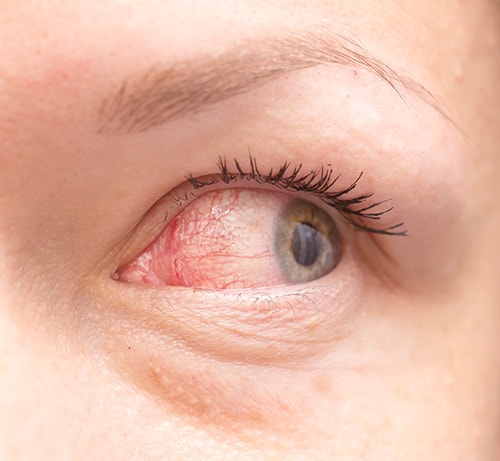
Close up of irritated red bloodshot eye
Acanthamoeba is one of the most common organisms in the environment, but it rarely causes infections. When infection does occur, however, it can be extremely serious and can threaten your vision.
Recently, there have been increasing reports of Acanthamoeba keratitis, which is a co-infection of Acanthamoeba with a bacterial keratitis. This infection commonly occurs in the contact lens case and on the cornea, complicating prevention, diagnosis and treatment.
Your best defense against Acanthamoeba keratitis infection is to maintain proper contact lens hygiene.
Symptoms
- A red, frequently painful eye infection that doesn’t improve with traditional treatment.
- Feeling of something in the eye, excessive tearing, light sensitivity and blurred vision.
- Red, irritated eyes that last for an unusually long time after removing your contact lenses.
Risk Factors
- Using tap water to clean and disinfect contact lenses—including the lens case.
- Swimming with contact lenses, especially in freshwater lakes and rivers. However, Acanthamoeba keratitis has been found in almost all water sources—from pools to hot tubs to showers.
- Failure to follow lens care instructions (see Lens Care Guide below).
Lens Care Guide
- Always wash hands before handling contact lenses.
- Rub and rinse the surface of the contact lens before storing.
- Use only sterile products recommended by your optometrist to clean and disinfect your lenses. Saline solution and rewetting drops are not designed to disinfect lenses.
- Avoid using tap water to wash or store contact lenses.
- Contact lens solution must be discarded upon opening the case, and fresh solution used each time the contact lens is placed in the case.
- Replace lenses using your doctor’s prescribed schedule.
- Do not sleep in contact lenses unless prescribed by your doctor and never after swimming.
- Never swap lenses with someone else.
- Never put contact lenses in your mouth or use saliva to wet the contact lens.
- See your optometrist regularly for contact lens evaluation.
- If you experience RSVP (redness, secretions, visual blurring or pain), return to your optometrist immediately!


